Constructed Wetland Kills Viruses

Constructed Wetland is an effective measure against viruses and other wastewater pollutants
Removal of pathogenic microorganisms from wastewater is crucial to prevent water resources contamination and to limit any risks for human health. Constructed Wetlands (see other articles on this topic on our website: 1, 2, 3) are today a well-established technology for wastewater treatment. Although very effective in the removal of organic matter and nutrients, the pathogen removal is also very effective in this modern and environmentally friendly water treatment technology.
Main categories of pathogens, which are related to waterborne diseases are: bacteria, parasites (helminthes), fungi, and viruses. Fecal pathogens in wastewater can cause waterborne diseases such as diarrhea, typhoid fever, dysentery, cholera, and others. Diarrhea is the third largest morbidity cause and the sixth largest mortality cause worldwide. It should also be noted that almost 80 % of global diarrhea cases are attributable to unsafe/untreated water, improper sanitation, or insufficient hygiene.
Conventional treatment methods such as activated sludge systems are usually applied worldwide for wastewater treatment, but they cannot completely remove pathogenic microorganisms from wastewater. Today, Constructed Wetlands are considered an established “green” technology for the treatment of wastewaters of various kinds and origins. It was the last 10–15 years that this technology met a tremendous increase in the worldwide inter- est and the respective number of full-scale applications, while research focus on these systems was also significantly intensified. Their noticeable expansion is mainly attributed to their multiple economic and environmental benefits, especially compared to other conventional treatment technologies:they are cheap, extremely efficient, require almost no external energy sources and are extremely easy to maintain. Constructed Wetlands can be an ideal solution for developing countries, where almost half of the global population lives.
The removal of pathogenic microorganisms in Constructed Wetlands is accomplished through a complex of chemical (e.g., oxidation, UV radiation by sunlight, plant biocides, adsorption), physical (e.g., filtration, sedimentation), and biological (e.g., predation, biolytic processes, antibiosis, natural die-off) factors, which often act in combination for the removal of pathogenic bacteria.

The effectiveness of the destruction of microorganisms in various types of wastewater and technologies of Constructed Wetland
Separately, it is necessary to note the currently extremely relevant possibility of treating wastewater from viruses in Constructed Wetland.
This occurs through several main different processes occurring here: sedimentation, absorption, filtration, eating macrophytes (bacteria hunting for viruses) and specific plant secretions. One of the most effective reasons for treating wastewater from viruses is their ingestion by bacteria, which in themselves are almost harmless to humans, or can, in turn, be destroyed by physical or chemical factors that are also active in Constructed Wetland. In a number of scientific studies on the treatment of wastewater from viruses by Constructed Wetlands, it was noted that in this way there can be at least 90 and up to 99% of all viral contaminants.
At the same time, a specific feature of Constructed Wetland in the removal of viruses is the fact that a significant part of them die in the bottom layer of sediments, where they fall after deposition. Thus, cleaning takes place in two stages: first, viruses are absorbed on various suspended particles in water, then they are deposited with them on the bottom, where they are easily found and destroyed by various macrophage predators and other hunters. Surviving viruses are likely to be eliminated by plant secretions and other ways. Therefore, when choosing a method for purifying water from viruses, it is necessary to pay attention to Constructed Wetland, especially those that imply the presence of not only superficial, but also internal runoff, and also use actively growing aquatic plants in their design.
Full Text:
Alexandros S. I., Akratos C. S. Removal of pathogenic bacteria in constructed wetlands: mechanisms and efficiency //Phytoremediation. – Springer, Cham, 2016. – P. 327-346.
Garcia J. et al. Contaminant removal processes in subsurface-flow constructed wetlands: a review //Critical Reviews in Environmental Science and Technology. – 2010. – V. 40. – N. 7. – P. 561-661.
